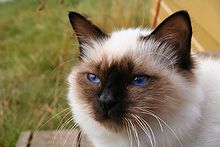Birman
| Birman | |
|---|---|

A seal point Birman
|
|
| Other names | Sacred Birman, Sacred Cat of Burma |
| Origin | France |
| Breed standards | |
| CFA | standard |
| FIFe | standard |
| TICA | standard |
| ACF | standard |
| ACFA/CAA | standard |
| CCA-AFC | standard |
| Domestic cat (Felis catus) | |
The Birman, also called the "Sacred Cat of Burma", is a domestic cat breed. The Birman is a long-haired, color-pointed cat distinguished by a silky coat, deep blue eyes, and contrasting white "gloves" or "socks" on each paw.
The breed name is derived from Birmanie, the French form of Burma. The Birman breed was first recognized in France by the Cat Club de France in 1925, then in England by the Governing Council of the Cat Fancy (GCCF) in 1966 and in United States by the Cat Fanciers' Association (CFA) in 1967. It is also recognized by the Canadian Cat Association (CCA) and the International Cat Association (TICA) in 1979.
No clear record of the breed's origin exists. They are most often claimed to have originated as the companions of temple priests in northern Burma in the Mount of Lugh. Many stories exist of how the cats first came to France, including pairs of cats being given as a reward for helping defend a temple, or being smuggled out of Burma by a Vanderbilt. Another pair of Birmans (or a pregnant female called Poupée de Maldapour) were said to have been stolen and later imported to France by Thadde Haddisch. The first traces of historical Birmans go back to a Mme Leotardi in the city of Nice in France.
Birmans were almost wiped out as a breed during World War II. Only two cats were alive in Europe at the end of the war, a pair named Orloff and Xenia de Kaabaa, both belonging to Baudoin-Crevoisier. The foundation of the breed in postwar France were offspring of this pair. They had to be heavily outcrossed with long-hair breeds such as Persian and Siamese to rebuild the Birman breed. By the early 1950s, pure Birman litters were once again being produced. The restored breed was recognized in Britain in 1965 and by the CFA in 1966 The first Birman cats were seal point. The blue point colour was introduced in 1959 using blue Persian lines. New colours were later added by English breeders including chocolate, red, and tabby/lynx points. Birmans have also been used in the development of new breeds, notably including the Ragdoll.
...
Wikipedia
